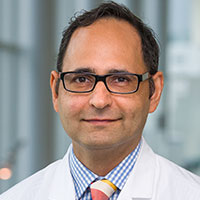New Patient Appointment or 214-645-8300

Sumeet S. Teotia, M.D. Answers Questions On: Breast Reconstruction
-
The word “flap” is used a lot in breast reconstruction. What does that refer to?
-
Flap means any tissue with a blood supply or that is generally connected to a main artery and vein. In flap procedures, we use tissue from other parts of the body to reconstruct the breast using a microscope to link the small arteries and veins in the chest or axilla (armpit). There are generally no breast implants involved.
There are various flap procedures in breast reconstruction after cancer. With a DIEP (deep inferior epigastric artery perforator) flap procedure, we use tissue from the abdomen to build the new breast. With a PAP (profunda artery perforator) flap, we use tissue from the inner and back of the thigh area. With a LAP (lumbar artery perforator) flap, we use tissue from the love handle region.
Also, stacked flaps join tissue from two different areas of the body and use various combinations (flaps) to reconstruct a breast. This procedure is more advanced and technically demanding, but our Breast Reconstruction Program at UT Southwestern routinely performs many of these surgeries.
-
When performing breast reconstructive surgery after cancer, what are the effects of taking tissue from one part of the body versus another?
-
When we take tissue from one part of the body, we call this the donor site. Oftentimes, the donor site is dependent on the patient’s body and will help us determine what type of flap should be performed.
The most common type of flap procedure after cancer is a DIEP flap. However, not everyone is a candidate. The Dallas breast reconstructive surgeons at UT Southwestern will discuss the options with each patient and choose the safest and most appropriate procedure.
Naturally, patients are generally focused on the end result, and the process can require several stages of reconstruction to yield the best result possible. Making the donor site as optimal as possible is also the goal because there is scarring associated with where the tissue comes from in the body.
Revisionary procedures after flap surgery often are necessary to optimize the donor site as well the overall harmony of the reconstructed breast with the patient's body.
-
Are there any advances in-flap based reconstructive breast surgery after cancer that patients can look forward to?
-
Various advances in reconstructive breast surgery are safe, reliable, and offer excellent results for patients after cancer.
As nipple-sparing mastectomies and double mastectomies remain popular among many patients, the options for various types of flaps have also widened. The focus now is not only breast reconstruction to achieve symmetry but also improving the donor site and balancing overall results for increased patient satisfaction.
Additionally, advanced breast microvascular surgery now offers alternative flaps besides DIEP, PAP, LAP, or combination flaps when the initial procedure fails. We’ve published articles on various secondary and tertiary flap-based procedures after previous failed flaps. Patients can have success with alternative flap methods thanks to the experience and team support at UT Southwestern.
During the last two decades, UT Southwestern’s breast microsurgery program has made strides in maximizing patient safety, improving operating room team environment and processes, developing ERAS (enhanced recovery after surgery) protocols, decreasing operative time, moving away from ICU settings, increasing overall patient satisfaction, minimizing the length of stay for routine DIEP flaps, and decreasing complications.
-
You’re also a classical artist and medical illustrator. How does that help you in your surgical practice and philosophy?
-
I’ve been an artist for most of my life, and I sought formal instruction early in my surgical career. Art, like surgery, is a lifetime of hard work and teaches humility and nature’s work.
Concentrating on developing my artistic skills not only makes me a better plastic surgeon but also brings calmness in my work and interaction with people around me, including patients and my family.
My medical art is an extension of the classical work I do in my spare time, and it’s mainly used for publications and teaching. I was the leading illustrator of the second edition of Surgical Recall, a popular handbook in general surgery, when I was a medical student and early resident.
Today, I still illustrate and draw unique surgical combinations in breast microsurgery and teach drawing concepts in small group sessions to medical students and plastic surgery residents.
Classical art and drawing provide me a keener sense of observation, and it permits me to better understand perspective, light, and shadows both analytically and scientifically. Art also allows me to see natural beauty in proportionate and natural terms, with every subject being unique, just like my patients.